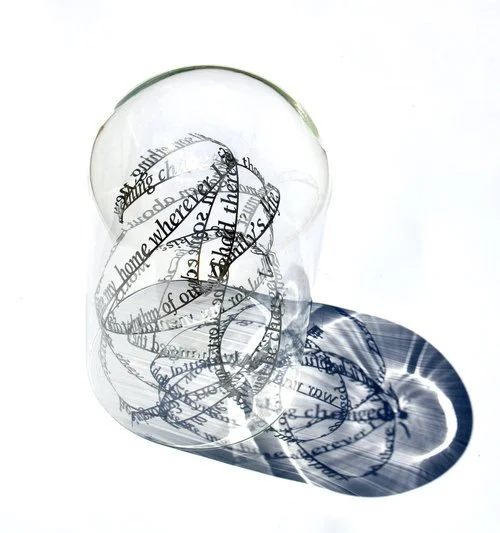Some great questions from Joydeep Sengupta in this interview in Khaleej Times about my new sculpture ‘See Things Differently’ for the UK Pavilion at Expo 2020 in Dubai.
You can read it here or scroll down for a plain text version
PLAIN TEXT:
Expo 2020 Dubai: UK artist's sculpture focuses on global climate crisis
Nicola Anthony's installation, which is being created live at the Expo site between Nov 1 and 9, draws attention to green causes and sustainability
Nicola Anthony creates a live sculpture at the UK Pavilion, Expo 2020 Dubai. Supplied photos
Published: Sun 7 Nov 2021, 7:10 PM
Last updated: Sun 7 Nov 2021, 7:20 PM
Nicola Anthony, an artist from the United Kingdom (UK), started the process to create a sculpture live at the UK Pavilion at Expo 2020 Dubai on November 1.
The visitors can see Anthony create the piece, which draws attention to issues around the environment and sustainability by connecting with online conversations on COP26, which started in Glasgow on December 31.
The sculpture will be presented alongside a host of talent from across the UK’s creative industries, during ‘In the Future, How Will We Create?’ — a five-day event, which starts this week, and seeks to explore how creativity can tackle some of the major challenges of our time.
Khaleej Times spoke to Anthony. Edited excerpts from the interview:
You tend to focus on untold narratives, collective memory, hybrid intelligence and the embodiment of life stories. How is that related to climate change and sustainability?
“To me, these are all ways of looking at the stories that we tell (as well as the ones which we don’t tell), and this led me to realise that humanity has a greater shared story: For example, my interest in untold narratives is what drives me to interview and get to know those whose life stories are not often heard. This helped me to understand the hidden traumas experienced by communities who have been displaced from their homes due to climate change. Hybrid intelligence is the combination of human and machine intelligence, which I find a fascinating way to see things differently — I recently started using big data to contrast human stories in my work, to interrogate what is truth and what is perception.”
How do you transform words into messages of profundity? For instance, your installation at the UK Pavilion in Expo 2020 Dubai.
“I think my work has been called profound because the human stories they contain are universal, and can connect deeply with others. I can humbly say that it’s the people I interview, who lend their depth to my art, allowing it to connect with others.
At the UK Pavilion, I focus on the global dialogue around climate change, and have created a way to measure the frequency, intensity and sentiment of the digital conversation around COP26. This will be represented in real-time by a seam of pulsing fibre optics running through the sculpture. To me it is truly profound to see individuals and communities raising their voices and working together towards sustainability.”
How can art create more awareness about contemporary burning issues?
“Artists have the ability to be ethical influencers. Art has a proud tradition of bringing to the forefront important issues and holding up a mirror to society. I believe that art can go further than this to become a catalyst, to reveal hidden sides to the complex issues of our time, and to provide new opportunities for understanding.”
How can creativity tackle some of the major challenges of our time?
“It enables us to find solutions through looking from a different perspective or turning a challenge on its head to reveal a hidden problem or hidden potential.
A skill that creatives learn the power of very early on is cross-discipline working, and collaboration. I am happy when I see this reflected in the push towards collaborating and knowledge sharing to tackle the climate crisis.
Creative minds are also taking on the challenge of social responsibility and designing sustainably, as well as helping to reframe and work towards solutions for the issues of climate crisis and climate justice.”
How do you collect human testimonies and transform them into contemporary art?
“For years, my art has told life stories, drawing out threads of commonality between people from all walks of life. I enjoy collecting my source material in many ways: interviewing people or gathering their memories through workshops; seeking the essence of society by looking at the history of our collective google queries; working with cultural archives of knowledge or aural histories; collaborating with poets, scientists, linguists and research bodies.”
Please elaborate on your other live culture sessions in the past.
“Some of the most meaningful projects I have worked on have involved live sessions or live archives. In previous projects I have looked at climate migration through working with the United Nations High Commissioner for Refugees (UNHCR) database and meeting with migrants all around the world to hear their stories first hand. I was commissioned by the Singapore Art Museum to go into Changi Prison to work with inmates, learning their life stories and the challenges they have faced, and in the process, I learned so much about our human nature and the capacity for compassion. I was invited by Steven Spielberg’s USC Shoah Foundation to work with their archives of testimonies of genocide, to create a sculpture for their entrance hall which speaks of the importance of equality and equity across all peoples.”














